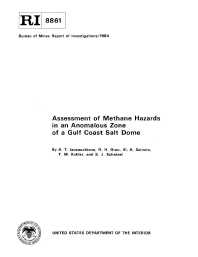Mining Publication: Assessment of Methane Hazards in an Anomalous Zone of a Gulf Coast Salt Dome
Original creation date: January 1984
This Bureau of Mines research study found gas emission rates from an advancing face, and flows and pressure of gas from an exploration drill hole were dependent upon the geology of salt encountered in a domal salt mine. Normal production-grade "pure" salt adjacent to an anomalous zone was found to have a methane emission rate of less than 5 ft3/ton (0.1 M3/t) of mined salt from a room advanced by a continuous miner. Extremely low gas flows [less the 4 ft3/h (0.1 M3/h)] and lack of pressure buildup were also observed from this normal salt in a 154-ft (47-m) exploration drill hole. These data indicate that methane emissions should not be a problem when mining in this type of salt. In the adjacent anomalous zone, methane emission rates ranged from 15 to 70 ft3/ton (0.4 to 1.8 M3/t) of mined salt from an advancing face. Gas flows of approximately 42 ft3/h (1.2 M3/h), and pressures in excess of 900 psig (6,200 kpa) were observed in an exploration drill hole when the anomalous zone was encountered. This information suggests a greater methane emission hazard from the anomalous zone than from the associated normal salt.
Authors: AT Iannacchione, RH Grau, A Sainato, TM Kohler, SJ Schatzel
Report of Investigations - January 1984
NIOSHTIC2 Number: 10003572
Pittsburgh, PA: U.S. Department of the Interior, Bureau of Mines, RI 8861, 1984 Jan; :1-26
See Also
- Investigation of Methane Emissions From an Advancing Face in the Belle Isle Domal Salt Mine, Louisiana
- Investigation of Methane Occurrence and Outbursts in the Cote Blanche Domal Salt Mine, Louisiana
- Managing Excess Gas Emissions Associated with Coal Mine Geologic Features
- Methane Absorption in Oil Shale and Its Potential Mine Hazard
- Methane Content of Gulf Coast Domal Rock Salt
- Methane Control by Isolation of a Major Coal Panel - Pittsburgh Coalbed
- Methane Diffusion Parameters for Sized Coal Particles: A Measuring Apparatus and Some Preliminary Results
- Methane Emission Rate Studies in a Northern West Virginia Mine
- Modeling and Prediction of Ventilation Methane Emissions of U.S. Longwall Mines Using Supervised Artificial Neural Networks
- Reservoir Rock Properties of Coal Measure Strata of the Lower Monongahela Group, Greene County (Southwestern Pennsylvania), from Methane Control and Production Perspectives
- Content source: National Institute for Occupational Safety and Health, Mining Program


 ShareCompartir
ShareCompartir
